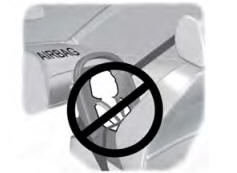Ford Explorer: Intake Air Distribution and Filtering - 2.3L EcoBoost (201kW/273PS) / General Procedures - Charge Air Cooler (CAC) Cleaning
Cleaning
-
Remove the CAC.
Refer to: Charge Air Cooler (CAC) (303-12A Intake Air Distribution and Filtering - 2.3L EcoBoost (201kW/273PS), Removal and Installation).
-
Remove the Turbocharger Boost Pressure Sensor from the CAC by removing the screw and gently pulling the sensor from the CAC.
-
NOTE: Do not use a high-pressure power washer to clean the CAC or damage to the CAC may occur.
NOTE: Drain all contaminates such as coolant, fuel and oil prior to cleaning the CAC.
NOTE: Thoroughly clean the joint clamp areas as well as the turbocharger connection, engine connection and the CAC connections, using motorcraft metal brake parts cleaner.
Lay the CAC flat with the inlet and outlet ports pointing up.
-
Add an appropriate amount of commercially available
detergent cleaner such as Simple Green Pro HD, or equivalent to the CAC. Follow the manufacturer's directions for cleaning. Fill the CAC to 40% of its volume with water.
-
Raise one end of the CAC and agitate it by hand for at least 5 minutes.
-
Raise the opposite end of the CAC and agitate it by hand for at least 5 minutes.
-
Drain the CAC.
-
Flush the CAC thoroughly with clean water.
-
Repeat Steps 3 through 8 until no contaminates are found in the flush water.
-
Allow the CAC to air dry.
-
NOTE: The following leak test steps must be performed prior to installing the CAC.
Install the turbocharger boost pressure sensor, retaining it with the screw.
Torque: 106 lb.in (12 Nm)
-
NOTE: Use a commercially available kit, such as the Johnson Manufacturing Company CAC Test Set Part No. 351-CAS, or equivalent.
Install the commercially available CAC tester on the CAC following the manufacturer's installation instructions.
-
NOTICE: Never exceed the specified pressure. Excessive pressure may cause the test adapter to blow off or may damage the charge air cooler (CAC). Failure to follow this instruction may result in serious personal injury.
Slowly apply air pressure.
Pressure: 21.8 psi ( 150 kPa)
-
Let the CAC stand for a few minutes and note any loss in pressure.
-
Release the air pressure.
-
Repeat Steps 13 through 15 as many times as necessary to
verify the readings. The reading is considered verified when 3
consecutive tests show approximately the same pressure drop.
-
NOTE: If the pressure loss exceeds 10 kPa (1.5 psi) per minute, install a new CAC
Install the CAC.
Refer to: Charge Air Cooler (CAC) (303-12A Intake Air Distribution and Filtering - 2.3L EcoBoost (201kW/273PS), Removal and Installation).
 Removal and Installation - Air Cleaner
Removal and Installation - Air Cleaner
Removal
NOTICE:
The turbocharger compressor vanes can be damaged by even the
smallest particles. When removing any turbocharger or engine air intake
system component, ensure that no debris enter..
Other information:
Ford Explorer 2020-2026 Service Manual: Description and Operation - Fuel Charging and Controls - Component Location
2..
Ford Explorer 2020-2026 Service Manual: Removal and Installation - Second Row Seatbelt Buckle - Police
Removal NOTE: Removal steps in this procedure may contain installation details. NOTE: LH (left-hand) shown, RH (right-hand) similar. Remove the second row seat. Refer to: Second Row Seat - Police (501-10B Second Row Seats, Removal and Installation)...
Categories
- Manuals Home
- 6th Generation Explorer Owners Manual
- 6th Generation Explorer Service Manual
- Automatic Transmission
- Traction Control
- Automatic Transmission - 10-Speed Automatic Transmission – 10R60
- New on site
- Most important about car
Children and Airbags
WARNING: Airbags can kill or injure a child in a child restraint. Never place a rear-facing child restraint in front of an active airbag. If you must use a forward-facing child restraint in the front seat, move the seat upon which the child restraint is installed all the way back.


